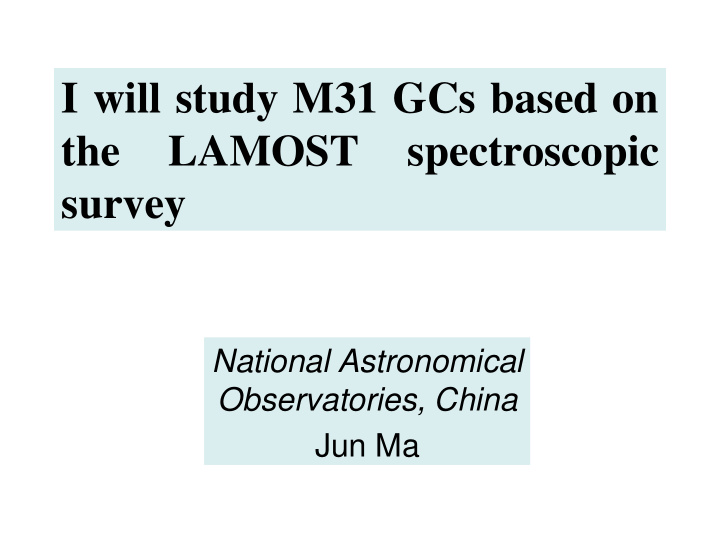



I will study M31 GCs based on the LAMOST spectroscopic survey National Astronomical Observatories, China Jun Ma
Contents: 1. An introduction of my scientific interests. 2. How could my work benefit from LAMOST observations?
1. An introduction of my scientific interests: My main field of scientific research includes: (1) Structure and arm shape of spiral galaxies; (2) Stellar populations of star clusters in extra- galaxies (mainly in M31, M33, and M81); (3) Structural and dynamical parameters of star clusters in extra-galaxies (mainly in M31, M33, and M88).
1. An introduction of my scientific interests: My main field of scientific research includes: (1) Structure and arm shape of spiral galaxies;
There is an increase in the mean pitch angles along the Hubble sequence.
1. An introduction of my scientific interests: My main field of scientific research includes: (2) Stellar populations of star clusters in extra-galaxies (mainly in M31, M33, and M81);
M31 includes some star clusters whose ages are younger than 6 Gyr.
1. An introduction of my scientific interests: My main field of scientific research includes: (3) Structural and dynamical parameters of star clusters in extra-galaxies (mainly in M31, M33, and M88).
In this paper, we found that one of objects, which was considered to be a GC, is not an ordinary GC, but an ultra- compact dwarf (UCD).
1. An introduction of my scientific interests: My main field of scientific research includes: My personal web page: http://batc.bao.ac.cn/~majun/
2. How could my work benefit from LAMOST observations? I will study M31 GCs based on the LAMOST spectroscopic survey.
M31 is the largest galaxy in the Local Group.
This figure shows the distribution of M31 GCs and candidates. Of them, for about 700 objects, their magnitudes are smaller than 18 mag in the V band. We will observe these luminous objects with the LAMOST.
Especially, these luminous objects includes 50 GCs in the outer halo of M31 ( R proj >30 kpc), and most of these outer halo GCs have not any spectroscopic data till now. They are mainly detected based on the Hubble images and CHFT.
What will we do based on the LAMOST data mentioned above? (1) We will provide a sample of spectral data (the LAMOST) for M31 star clusters, which includes the outer halo GCs for the first time. (2) We will derive the radial velocities, metallicities, and ages in the same system (the LAMOST) based on the full spectral fitting technique.
What will we do based on the LAMOST data mentioned above? (3) For the first time, we will divide the star clusters into three groups: young (< 1 Gyr), medium (between 1 Gyr and 8 Gyr), and old (> 8Gyr), and study each of three groups in detail, such as a distribution of metallcity and kinematic properties, and so on.
What will we do based on the LAMOST data mentioned above? (4) We will compare the properties of the star clusters in the outer, inner haloes and in the disk in detail, and understand the history of formation and evolution of M31, especially the interacting history of between M31 and its dwarf galaxies and M33.
What will we do based on the LAMOST data mentioned above? (5) For old star clusters in M31, we will study their distribution of metallicity in detail, and present the statistical results of their rotational velocities. And we will derive a definite birth of metal-poor GCs in M31, and compare them with the Milky Way counterparts.
This is my preliminary idea that how to study M31 star clusters based on the LAMOST.
Thank you for listening.
Recommend
More recommend